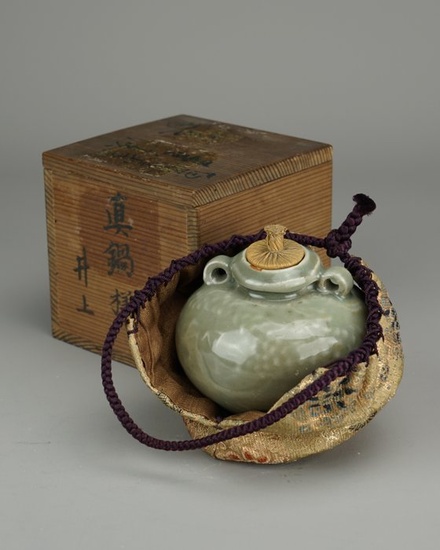Longquan celadon tea caddy - Porcelain - Slip-decorated Dragon - China - Yuan Dynasty (1279-1368)
A slip-decorated 'Longquan' celadon glazed tea-caddy, Yuan/Ming dynasty 14th century decorated with a dragon chasing a flaming pearl of wisdom, above crashing waves near the foot. The small jarlet has two small round ears on either side of the flared mouth.
The jarlet has been used by a Japanese tea-master as a 'caire' or tea-caddy for matcha green tea powder and thus comes with an inscribed tomobako box, a nice brocade silk shifuku pouch and bamboo-leave stopper. The somewhat slanted mouth and baking flaw at the belly of the jarlet would make is desirable due to wabi-sabi aesthetics in vogue with tea-master.
Import of Longquan ware to Japan started during the Yuan dynasty by Buddhist monks. The Tenryu-ji temple in Kyoto had the sole right for import and distribution of Longquan ware. Thus old Longquan ware is often called Tenryu ware in Japanese. This tea caddy probably was sold true this temple.
Reference:
A similar jarlet in The Art Gallery of New South Wales: https: //www. artgallery. nsw. gov. au/collection/works/65. 2012/
Condition:
Very good condition. Only baking flaws at the belly. The tomobako box has tape residue.
Dimensions :
H7 x 8. 2 cm
Shipping method: The item is securely packed and shipped with insurance without stand or doll house vase.
View it on
Sale price
Estimate
Time, Location
Auction House
A slip-decorated 'Longquan' celadon glazed tea-caddy, Yuan/Ming dynasty 14th century decorated with a dragon chasing a flaming pearl of wisdom, above crashing waves near the foot. The small jarlet has two small round ears on either side of the flared mouth.
The jarlet has been used by a Japanese tea-master as a 'caire' or tea-caddy for matcha green tea powder and thus comes with an inscribed tomobako box, a nice brocade silk shifuku pouch and bamboo-leave stopper. The somewhat slanted mouth and baking flaw at the belly of the jarlet would make is desirable due to wabi-sabi aesthetics in vogue with tea-master.
Import of Longquan ware to Japan started during the Yuan dynasty by Buddhist monks. The Tenryu-ji temple in Kyoto had the sole right for import and distribution of Longquan ware. Thus old Longquan ware is often called Tenryu ware in Japanese. This tea caddy probably was sold true this temple.
Reference:
A similar jarlet in The Art Gallery of New South Wales: https: //www. artgallery. nsw. gov. au/collection/works/65. 2012/
Condition:
Very good condition. Only baking flaws at the belly. The tomobako box has tape residue.
Dimensions :
H7 x 8. 2 cm
Shipping method: The item is securely packed and shipped with insurance without stand or doll house vase.



